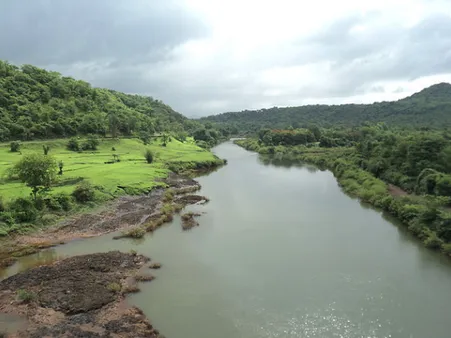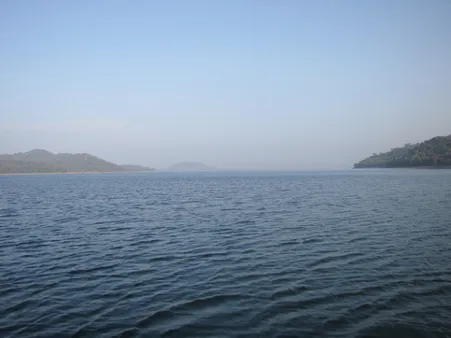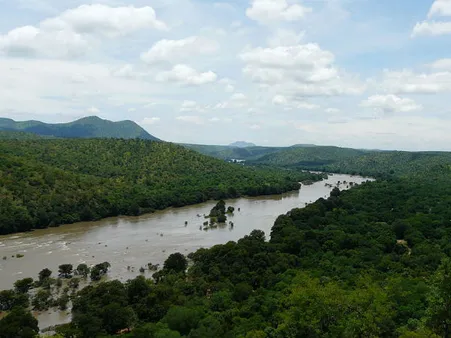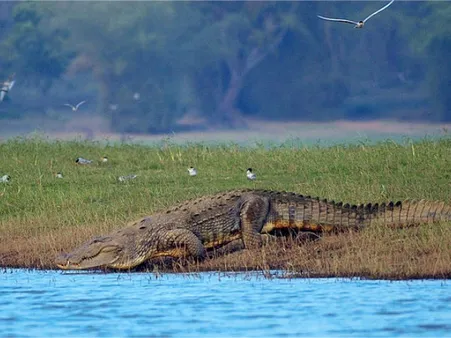🚗🏍️ Welcome to Motoshare!
Turning Idle Vehicles into Shared Rides & New Earnings.
Why let your bike or car sit idle when it can earn for you and move someone else forward?
From Idle to Income. From Parked to Purpose.
Earn by Sharing, Ride by Renting.
Where Owners Earn, Riders Move.
Owners Earn. Riders Move. Motoshare Connects.
With Motoshare, every parked vehicle finds a purpose. Partners earn. Renters ride. Everyone wins.

The Varahi River is a serene and powerful waterway that flows through the lush Western Ghats in Karnataka, playing an essential role in the landscape and culture of the region. Originating at Hebbagilu, near Agumbe in Shimoga district, the river meanders through a total distance of 66 kilometers before merging with the Arabian Sea near Kundapura. This westward-flowing river passes through Basrur, Kundapura, and Gungulli, and on its journey, it unites with other rivers like the Souparnika, Kedaka, Chakra, and Kubja. Its course through the verdant Western Ghats makes it a central lifeline for the region, offering opportunities for hydroelectric power, tourism, and cultural significance.
Varahi River: The Flowing Jewel of Karnataka’s Western Ghats
| Category | Details |
|---|---|
| River Name | Varahi River |
| Origin | Hebbagilu, near Agumbe, Western Ghats, Shimoga District, Karnataka |
| Length | 66 km |
| Catchment Area | 759 sq. km |
| Flow Direction | Westward, eventually meeting the Arabian Sea near Kundapura |
| Tributaries | Souparnika River, Kedaka River, Chakra River, Kubja River |
| Famous Waterfalls | Kunchikal Falls (falls 455 meters, one of the highest in India) |
| Key Attractions | Rafting (Hosangady to New Bridge), Sankaranarayana Temple |
| Hydroelectric Project | Varahi Hydroelectric Project (underground station near Siddapura, Udupi District) |
| Nearby Temples | Sankaranarayana Temple, Kundeswara Temple, Anegudde Sri Vinayaka Temple |
| Nearby Attractions | Jog Falls, Kollur Mookambika Temple, Kodachadri, Agumbe, Maravanthe Beach |
| Best Time to Visit | October to March (avoid monsoon season for outdoor activities) |
| Adventure Activities | River rafting, trekking (Kodachadri, Kunchikal Falls), wildlife exploration (Mandagadde Bird Sanctuary) |
| Cultural Significance | Religious festivals at Sankaranarayana Temple, rituals and pujas near the riverbanks |
| How to Reach (Nearest Railway) | Kundapura (Konkan Railway) |
| How to Reach (Nearest Airport) | Mangalore International Airport (100 km from Kundapura) |
| How to Reach (Road Transport) | Well connected by road, buses from Udupi, Shimoga, Mangalore |
| Important Helplines | Police: 100, Ambulance: 108, Fire: 101, Tourism Helpline: 1800-425-46464 |
| Tips & Suggestions | Carry cash, wear comfortable shoes for trekking, check water levels for rafting, respect local customs |
| Local Food to Try | Akki Roti, Neer Dosa, Ragi Mudde, Mangalore Buns, Kane Fry |
| Things to Carry | Comfortable footwear, rain gear (monsoon), sunscreen, snacks, water, cash, first-aid kit |
Key Features of the Varahi River
- Origin: The Varahi River begins its journey in the Western Ghats at Hebbagilu near Agumbe, a region famous for its lush greenery and high rainfall. Agumbe is often referred to as the “Cherrapunji of South India.”
- Length and Catchment Area: The river covers a total length of 66 km and has a catchment area of 759 square kilometers. It plays a critical role in the local ecosystem and agriculture.
- Tributaries: The river joins hands with the Souparnika, Kedaka, Chakra, and Kubja Rivers along its journey, further enriching the water sources of the Western Ghats before it finally empties into the Arabian Sea near Kundapura.
- Hydroelectric Project: The Varahi River is harnessed for hydroelectric power through a dam near Yadur. This project is significant for electricity production in the region, with an underground electricity-generating station built by KPCL near Siddapura in Udupi district. The Varahi Hydroelectric Project is a unique feature, providing clean energy to the state.
- Kunchikal Falls: As the river flows for 25 kilometers, it cascades down 455 meters to form the magnificent Kunchikal Falls, one of the highest waterfalls in India. This natural wonder is a major attraction for tourists seeking scenic beauty and adventure.
- Rafting on the Varahi River: Adventure seekers can enjoy rafting on the Varahi River, with stretches from Hosangady to New Bridge (24 km) or from Hosangady to Hole Shankaranarayan (18 km). Rafting here is a thrilling experience, available throughout the year except during the monsoon season (June to August).
Cultural and Spiritual Significance
The Varahi River is not only a lifeline for the regions it flows through but also holds deep cultural and spiritual importance. The river’s connection to local temples, spiritual traditions, and rituals has made it a revered waterbody in Karnataka. Here’s a closer look at its cultural and spiritual significance:
1. Sankaranarayana Temple
- Location: On the banks of the Varahi River.
- Significance: One of the most notable temples situated on the banks of the Varahi River is the Sankaranarayana Temple. This temple is a unique place of worship as it is dedicated to Sankaranarayana, a form that combines two deities—Shiva (Shankara) and Vishnu (Narayana). This rare blend of Shaivism and Vaishnavism attracts pilgrims who come to seek blessings from both deities in a single form. The tranquil surroundings of the river enhance the spiritual ambiance of the temple, making it a place of peace and devotion.
- Religious Importance: The temple is a significant pilgrimage site, especially for devotees of both Shiva and Vishnu, reflecting the deep-rooted belief in harmony between different spiritual paths.
2. River as a Sacred Waterbody
- Ritualistic Importance: Rivers have long been considered sacred in India, and the Varahi River is no exception. It is revered as a life-giving force and is often used for ritual baths during festivals and auspicious occasions. Bathing in the river is believed to wash away sins and purify the soul. The locals also perform various religious rites on the banks of the river, making it a focal point for community gatherings.
- Spiritual Symbolism: The river’s journey through the sacred Western Ghats and its confluence with other rivers symbolize the flow of life and the interconnectedness of nature and spirituality. It is often invoked in prayers and rituals as a symbol of purity and divine energy.
3. Kundeswara Temple (Kundapura)
- Location: Near the confluence of Varahi River with other rivers in Kundapura.
- Significance: The Kundeswara Temple, dedicated to Lord Shiva, is another spiritually significant site near the Varahi River. The temple is surrounded by scenic water bodies and coconut trees, creating a serene atmosphere that draws devotees seeking spiritual solace. The temple plays a central role in the religious life of the locals, and festivals here are celebrated with great fervor, with the river often playing a part in the rituals.
- Cultural Importance: The town of Kundapura, surrounded by water on three sides, is culturally rich, and the temple serves as a hub for both religious and cultural activities, including local festivals, processions, and community gatherings.
4. Basrur – The Temple Town
- Location: On the southern banks of the Varahi River.
- Significance: Basrur, situated on the banks of the Varahi River, is home to many ancient temples, making it a significant spiritual and historical center. The town is dotted with several temples dedicated to different deities, each holding its own historical and spiritual importance. The presence of the Varahi River has elevated the town’s status as a place of pilgrimage, where devotees come to perform rituals and seek blessings.
- Cultural Heritage: Basrur has a rich cultural heritage, and its temples showcase architectural brilliance, with many structures dating back centuries. The connection to the river adds a layer of sanctity to the town’s religious traditions.
5. Anegudde Sri Vinayaka Temple
- Location: Between Kota and Koteshwar towns, near the Varahi River.
- Significance: Located near the Varahi River, the Anegudde Sri Vinayaka Temple is one of the most famous Ganesh temples in the region. The temple, perched on a small hillock, is dedicated to Lord Ganesha and attracts thousands of devotees each year. The temple’s setting, near the river and surrounded by lush greenery, makes it a spiritually uplifting destination.
- Cultural Importance: The temple is a key cultural hub for the local community, with festivals like Ganesh Chaturthi celebrated with grandeur. The temple’s name, “Ane” meaning elephant and “Gudde” meaning hillock in Kannada, further connects it to Lord Ganesha’s symbolism as the remover of obstacles.
6. Religious Festivals and Rituals
- Festivals: Festivals like Ganesh Chaturthi, Shivaratri, and Makar Sankranti are celebrated with great devotion on the banks of the Varahi River. During these times, the river becomes the center of religious rituals, with devotees taking holy dips and offering prayers to the gods.
- Rituals: The river is also essential for conducting various religious rituals such as tarpana (ritual offering to ancestors), pujas (prayers), and aarti (ceremonial worship), especially during auspicious times of the year. The natural beauty of the Varahi River adds a spiritual depth to these practices, enhancing the overall experience for devotees.
Places to Visit Around the Varahi River

The Varahi River, flowing through the scenic Western Ghats, is surrounded by several beautiful destinations that showcase the natural beauty, spiritual significance, and cultural richness of the region. Whether you’re a nature enthusiast or a history buff, these attractions near the Varahi River provide a diverse range of experiences for travelers.
1. Kundeswara Temple (Kundapura)
- Location: Kundapura
- Description: The Kundeswara Temple, dedicated to Lord Shiva, is a prominent religious site located in the town of Kundapura, near the Varahi River. The town is uniquely situated, surrounded by water on three sides, offering scenic views of the river and backwaters. The temple is a hub for religious activities and an important spiritual center in the region.
- Highlight: Scenic views of the backwaters, traditional architecture, and a peaceful temple environment.
- Best Time to Visit: Early morning or evening to enjoy the calm atmosphere.
2. Anegudde Sri Vinayaka Temple
- Location: Kumbhashi, 5 km from Kundapura
- Description: The Anegudde Sri Vinayaka Temple is one of the most revered temples in Karnataka, dedicated to Lord Ganesha. It is located on a small hillock, giving it the name Anegudde (Ane means elephant, and Gudde means hill in Kannada). The temple is surrounded by lush greenery and is a significant pilgrimage site for devotees seeking blessings from the elephant-headed deity.
- Highlight: Hilltop temple, spiritual atmosphere, and breathtaking surroundings.
- Best Time to Visit: During Ganesh Chaturthi when the temple is bustling with celebrations.
3. Basrur
- Location: On the southern banks of the Varahi River, near Kundapura
- Description: Basrur is an ancient town steeped in history, located on the southern banks of the Varahi River. It is home to numerous temples and historical structures, making it a significant cultural and religious hub. The temples in Basrur are known for their traditional architecture, and the town holds great historical importance as a center for trade and spirituality in the past.
- Highlight: Ancient temples, historical significance, and a peaceful riverside town.
- Best Time to Visit: Anytime during the year, especially during temple festivals.
4. Uppinakudru (Salt Island)
- Location: 6 km from Kundapura
- Description: Uppinakudru, meaning “Salt Island,” is a small but historically significant island located near Kundapura. It was once a major center for salt production and maritime trade. The island is known for its scenic beauty and cultural heritage, offering visitors a glimpse into its historical past while enjoying the surrounding natural landscape.
- Highlight: Picturesque island, rich in history and culture.
- Best Time to Visit: Throughout the year, but especially during the winter season when the weather is pleasant.
5. Hoovinakere
- Location: Near Varahi River, Kundapura Taluk
- Description: Hoovinakere is the birthplace of the great philosopher Vadiraja Tirtha, who was a prominent preacher of the Dvaita philosophy after the renowned Madhvacharya. The town is an important spiritual center, with many devotees visiting to pay homage to this great thinker. The area around Hoovinakere is lush and green, providing a peaceful retreat for those seeking spiritual solace.
- Highlight: Spiritual significance, birthplace of a revered philosopher.
- Best Time to Visit: Any time of the year for a peaceful spiritual experience.
6. Kunchikal Falls
- Location: Near Mastikatte, in the Western Ghats
- Description: The Kunchikal Falls is formed by the Varahi River as it cascades down 455 meters, making it one of the highest waterfalls in India. The falls are a stunning sight, surrounded by dense forests and rugged terrain, offering a thrilling experience for nature lovers and adventurers. This waterfall is a major attraction for those who love trekking and exploring the wild beauty of the Western Ghats.
- Highlight: One of India’s highest waterfalls, surrounded by dense greenery.
- Best Time to Visit: During or just after the monsoon season (July to October) when the waterfall is at its fullest.
7. Kollur Mookambika Temple
- Location: 35 km from Kundapura
- Description: The Kollur Mookambika Temple is one of the most famous pilgrimage sites in South India. Dedicated to Goddess Mookambika, it is located near the Kodachadri hills and is considered one of the sacred Shakti Peethas. The temple is set against the backdrop of lush greenery, with the Varahi River adding to its spiritual charm. The peaceful environment and religious significance make it a must-visit for devotees and nature lovers alike.
- Highlight: Famous Shakti Peetha, serene surroundings, spiritual significance.
- Best Time to Visit: During Navaratri or Mookambika Jayanthi for a festive experience.
8. Agumbe
- Location: Near the source of the Varahi River in the Western Ghats
- Description: Known as the “Cherrapunji of South India” due to its heavy rainfall, Agumbe is a beautiful hill station famous for its stunning sunsets and rich biodiversity. Agumbe is also known for its rainforests, which are home to a variety of flora and fauna, including the rare King Cobra. The town offers various trekking opportunities and is a paradise for nature lovers.
- Highlight: Trekking, rich biodiversity, famous for its sunsets.
- Best Time to Visit: October to March for trekking and clear skies.
9. Maravanthe Beach
- Location: 20 km from Kundapura
- Description: Maravanthe Beach is a unique beach destination where the Arabian Sea meets the Suparnika River, creating a stunning landscape where the road runs between the river on one side and the sea on the other. The beach is known for its pristine sands, clear waters, and picturesque views, making it an ideal spot for relaxing and enjoying the sunset.
- Highlight: Scenic beauty, unique landscape with the sea and river running parallel.
- Best Time to Visit: November to March for pleasant weather.
Nearby Attractions

The Varahi River and its surrounding areas are home to several fascinating attractions that offer a mix of natural beauty, spiritual experiences, and cultural richness. Whether you’re exploring the lush Western Ghats or the historical temples, these nearby attractions are worth visiting for a complete experience.
1. Jog Falls
- Location: 110 km from Varahi River, Shimoga District
- Description: Jog Falls, formed by the Sharavathi River, is one of the highest waterfalls in India and a major attraction in Karnataka. With a plunge of over 830 feet, the waterfall creates a spectacular sight, especially during the monsoon season when it is in full flow. It’s surrounded by dense greenery, making it a great spot for nature lovers and trekkers.
- Highlight: One of the highest waterfalls in India, trekking, scenic beauty.
- Best Time to Visit: Monsoon season (June to October) for the fullest view of the falls.
2. Agumbe
- Location: 30 km from the source of the Varahi River
- Description: Often called the “Cherrapunji of South India” due to its heavy rainfall, Agumbe is a scenic hill station known for its stunning sunsets, lush rainforests, and rich biodiversity. It is also home to the famous King Cobra and is a paradise for wildlife enthusiasts and trekkers.
- Highlight: Scenic sunsets, trekking, biodiversity, and rainforests.
- Best Time to Visit: October to March for trekking, or during the monsoon to experience the region’s lush greenery.
3. Kodachadri
- Location: 40 km from Varahi River, Western Ghats
- Description: Kodachadri is the highest peak in the Shimoga district and a popular trekking destination. It offers breathtaking views of the Western Ghats and the surrounding forests. The trek to Kodachadri is filled with natural beauty, including waterfalls, dense woods, and panoramic views of the Arabian Sea. The Kollur Mookambika Temple is located nearby, adding a spiritual aspect to the trek.
- Highlight: Trekking, panoramic views, nearby Kollur Mookambika Temple.
- Best Time to Visit: October to March for trekking.
4. Kollur Mookambika Temple
- Location: 35 km from Varahi River, near Kodachadri
- Description: The Kollur Mookambika Temple is one of the most important pilgrimage sites in South India, dedicated to Goddess Mookambika. Situated at the foothills of the Kodachadri peak, the temple is surrounded by lush greenery and is a serene place for devotees and visitors alike. It is considered one of the Shakti Peethas, where the divine feminine energy is worshipped.
- Highlight: Sacred pilgrimage site, spiritual ambiance, surrounded by natural beauty.
- Best Time to Visit: During Navaratri or Mookambika Jayanthi for grand celebrations.
5. Achakanya Falls
- Location: 40 km from Thirthahalli, near Varahi River
- Description: Achakanya Falls is located on the Sharavathi River and is a hidden gem for waterfall lovers. The falls are a peaceful and picturesque spot surrounded by greenery and are ideal for a relaxing nature walk or picnic. The area is relatively less crowded, making it a great place for those looking to escape the hustle and bustle.
- Highlight: Scenic waterfall, ideal for picnics and nature walks.
- Best Time to Visit: Monsoon season (June to October) when the waterfall is at its best.
6. Tunga Dam
- Location: 10 km from Shimoga city
- Description: The Tunga Dam, built on the Tunga River, is a major attraction near Shimoga. It is a serene location surrounded by greenery and is an ideal spot for picnics and relaxation. The dam is an essential source of water for the region and offers scenic views of the river and the surrounding landscape.
- Highlight: Scenic views, perfect for picnics and relaxation.
- Best Time to Visit: Throughout the year, except during the summer when water levels may be low.
7. Koodli
- Location: 16 km from Shimoga
- Description: Koodli is the confluence point of the Tunga and Bhadra rivers and holds significant religious importance. It is a popular spot for performing rituals and prayers, especially for Hindus. The site also features several ancient temples and is a peaceful place for visitors looking for a spiritual experience in nature.
- Highlight: Confluence of Tunga and Bhadra rivers, religious importance.
- Best Time to Visit: Anytime during the year, but festivals and religious events add to the spiritual atmosphere.
8. Mandagadde Bird Sanctuary
- Location: 30 km from Shimoga
- Description: The Mandagadde Bird Sanctuary is a small but important bird sanctuary located on an island in the Tunga River. It is home to several species of migratory birds, making it a paradise for birdwatchers. The best time to visit is during the monsoon when thousands of birds flock to the sanctuary to breed.
- Highlight: Birdwatching, nature photography.
- Best Time to Visit: July to September, during the monsoon season.
9. Maravanthe Beach
- Location: 20 km from Kundapura
- Description: Maravanthe Beach is a unique beach where the Arabian Sea runs parallel to the Suparnika River, creating a stunning landscape. The road between the sea and the river makes it a picturesque spot, ideal for a relaxing day by the water. The beach offers beautiful sunset views and is a popular spot for tourists.
- Highlight: Pristine beach, unique setting between the sea and river.
- Best Time to Visit: November to March for pleasant weather.
How to Reach
- Nearest Railway Station: Kundapur Railway Station, about 4 km from town, is part of the Konkan Railway, connecting it to Mumbai and Mangalore.
- Nearest Airport: Mangalore International Airport, located around 100 km from Kundapur, is the closest airport.
- Road Transport: Kundapura is well connected by road, with frequent buses from Udupi and other parts of Karnataka.
Best Time to Visit
The Varahi River and its surrounding areas can be visited throughout the year, except during the monsoon season (June to August) when rafting and other outdoor activities are halted due to heavy rains.
Local Authentic Food to Have Around the Varahi River
Here is a list of local authentic food to try in the regions around the Varahi River and Shimoga:
- Akki Roti – A traditional rice flour flatbread typically served with spicy chutneys.
- Ragi Mudde – Nutritious finger millet balls, often eaten with spicy curries or sambar.
- Bisi Bele Bath – A hot lentil rice dish cooked with vegetables and aromatic spices.
- Neer Dosa – A soft, thin rice crepe that is light and often served with coconut chutney.
- Kane Fry – A specialty fish fry made with ladyfish, marinated with spices and shallow-fried.
- Mangalore Buns – Sweet, fluffy banana puris that are perfect for breakfast or snacks.
- Kori Rotti – A combination of crispy rice wafers served with spicy chicken curry.
- Pathrode – A dish made from colocasia leaves layered with spicy rice batter and steamed.
- Holige/Obbattu – A sweet flatbread stuffed with jaggery and lentil mixture, typically made during festivals.
- Jackfruit Curry – A unique curry made with tender jackfruit, showcasing the local flavors.
Things to Carry for Your Trip to Varahi River Region
When visiting the Varahi River region and its surroundings, especially for outdoor activities like trekking, rafting, or exploring natural attractions, it’s important to pack appropriately. Here’s a list of essential items to carry:
Things to Carry for Your Trip to Varahi River Region:
- Comfortable Footwear – Sturdy trekking shoes or sports shoes for hiking and exploring uneven terrain.
- Weather-Appropriate Clothing – Light, breathable clothes for summer, and a light jacket or shawl for cooler evenings. Waterproof clothing is recommended during monsoon.
- Rain Gear – Umbrella or raincoat, especially if traveling during the monsoon season.
- Water Bottle – Stay hydrated while exploring. Carry a refillable water bottle.
- Snacks – Pack some energy bars, nuts, or fruits for treks or long sightseeing trips.
- Sunscreen – High SPF sunscreen to protect from the sun, especially when trekking or rafting.
- Insect Repellent – Essential for protection from mosquitoes and bugs, especially near rivers and forests.
- Hat and Sunglasses – To shield yourself from the sun during the day.
- First-Aid Kit – Basic first-aid essentials, including band-aids, antiseptic, and any personal medications.
- Camera/Smartphone – To capture the beautiful landscapes and scenic views.
- Power Bank – Ensure your phone and other devices stay charged, especially if you’re in remote areas.
- Identification Documents – Carry your ID proof for hotel check-ins or other necessary permissions.
- Backpack – A comfortable backpack to carry your essentials during hikes or day trips.
- Torch/Flashlight – Handy for exploring caves or areas with limited lighting.
- Cash – While card payments are widely accepted in larger towns, cash is essential for smaller towns and remote areas.
Tips & Suggestions

- Best Time to Visit: The ideal time to explore the Varahi River and surrounding areas is from October to March when the weather is pleasant. Avoid the monsoon season (June to August) for trekking and rafting, as heavy rains can make activities difficult and dangerous.
- Monsoon Travel: If visiting during the monsoon, be prepared for slippery paths and unpredictable weather. Carry proper rain gear, waterproof bags, and be cautious while trekking near waterfalls and rivers.
- Respect Local Culture: Many attractions, especially temples such as Kollur Mookambika Temple and Sankaranarayana Temple, are deeply spiritual. Dress modestly and follow local customs when visiting religious sites.
- Carry Cash: While bigger towns like Kundapura may have ATMs and card facilities, smaller villages and local shops may only accept cash. It’s wise to carry some cash for purchases and entry fees.
- Trekking Safety: For adventurous activities like trekking to Kunchikal Falls or Kodachadri, ensure you wear proper footwear and carry enough water and snacks. Trek with a guide if you’re unfamiliar with the trails, as some paths can be tricky or unmarked.
- Book in Advance: If you plan to go rafting or stay at resorts near popular spots like Kundapura or Agumbe, book your accommodation and activities in advance, especially during peak seasons.
- Wildlife Awareness: When trekking through forests or visiting sanctuaries like Mandagadde Bird Sanctuary, be respectful of the local wildlife. Avoid loud noises and follow safety guidelines from local authorities or guides.
- Stay Hydrated: Due to the tropical climate, it’s easy to get dehydrated, especially if engaging in activities like trekking or rafting. Carry a water bottle and drink water regularly.
- Photography: The Western Ghats and riversides offer stunning photo opportunities. Make sure your camera or smartphone is fully charged, and consider carrying a power bank, especially if you’re exploring remote areas.
- Local Cuisine: Don’t miss out on trying local authentic food like Neer Dosa, Ragi Mudde, and seafood dishes. Explore local eateries to get a real taste of Karnataka’s coastal and Malnad flavors.
- Check River Conditions: If you plan to go rafting on the Varahi River, check the water conditions and availability of the activity beforehand, as rafting may be closed during the monsoon or if water levels are too low.
- Eco-Friendly Practices: The Varahi River and surrounding areas are ecologically sensitive zones. Be mindful of littering and pollution. Carry your trash with you and dispose of it responsibly.
Emergency Contact Numbers
- Police: 100
- Toll-free number for emergency police assistance anywhere in India.
- Ambulance: 108
- Toll-free number for emergency medical services, available 24/7 across Karnataka and other states.
- Fire Emergency: 101
- Toll-free number to report fire emergencies.
- Disaster Management Helpline: 1070
- Toll-free number for assistance during natural disasters or emergencies.
- Highway Emergency/Accident Helpline: 1033
- Toll-free number for roadside assistance, accidents, and emergencies on national highways.
- Child Helpline: 1098
- Toll-free number for children in distress.
- Tourism Information: 1800-425-46464
- Toll-free number for Karnataka Tourism. You can inquire about tourist information, places, and emergencies.
- Karnataka State Road Transport Corporation (KSRTC): 1800-425-1663
- Toll-free number for KSRTC-related inquiries about bus services, tickets, and emergencies.
- Electricity Complaint Helpline: 1912
- Toll-free number for electricity-related complaints and emergencies in Karnataka.
- Karnataka Forest Department (Wildlife Protection): 1800-425-1314
- Toll-free number for reporting wildlife issues, forest fire alerts, or wildlife assistance.
Conclusion
The Varahi River, with its cascading waterfalls, adventure activities, cultural landmarks, and surrounding natural beauty, is one of Karnataka’s hidden gems. Whether you seek spiritual solace at its riverside temples or adventure through its challenging rafting routes and scenic treks, the Varahi River and its neighboring areas in Shimoga offer a diverse and unforgettable experience.
Video link
